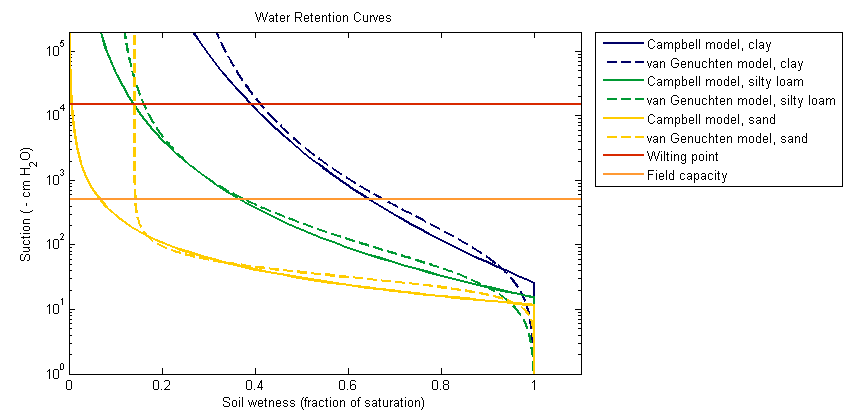SHP Project Home
Introduction to Soil Hydraulic Properties (SHPs)
A water retention curve describes the drying process of a particular soil. It is a nonlinear, experimentally-determined relationship between the suction (or tension) exerted by a soil on the surrounding moisture and the soil’s relative water content or wetness. The suction is measured by a negative pressure, commonly centimeters of water, and the relative water content is a fraction of the saturated water volume. A variety of models have been developed to describe this nonlinear curve. The most common are the Campbell (Campbell, 1974), the Clapp and Hornberger (Clapp & Hornberger, 1978), and the van Genuchten (Van Genuchten, 1980) models. Each model has a set of curve-fitting parameters known as soil hydraulic properties (SHPs). SHPs are a combination of empirically and theoretically derived values, which include the saturated water content, the saturated hydraulic conductivity, and various coefficients and exponents unique to each model.
SHPs are often approximated by their soil texture class as described by Cosby et al. (1984). Class average values for the van Genuchten parameters are provided by the United States Department of agriculture . Sommer and Stöckle (2010) provide empirical regression equations to translate van Genuchten SHPs into Campbell SHPs. Figure 1 shows water retention curves for an average clay, silty loam, and sand as defined by the van Genuchten and Campbell models.

Figure 1. Plot of soil tension versus soil wetness for two models' representations of a hypothetical clay, silty loam, and sand.
Some notable thresholds in any water retention curve:
- Saturation. At the water table and within a few centimeters above it, the suction on the soil matrix is zero or small enough that all pore space in the soil remains filled.
- Air entry point. Also known as bubbling point, this is where the suction is finally large enough to bring air into the soil matrix. At this location, there is a sharp decline in water content. The Campbell model shows this as a discontinuity in the water retention cuve. The van Genuchten model smooths the air entry over a few centimeters.
- Field capacity. At approximately 500 cm, gravity drainage ceases (Clapp & Hornberger, 1978). After this point, the dominant mechanism for soil drying is through plant transpiration.
- Permanent wilting point. As water content decreases, the tension by which the remaining moisture is sorbed to the soil increases. Plants rely on a water potential of their own to draw water up to their leaves. Wilting occurs when the soil tension is greater than the plants are able to overcome. The permanent wilting point, estimated to be at -15,300 cm H2O, is where the plant undergoes a loss in turgor that is irrecoverable (Tolk, 2003).
References
Campbell, G. S. (1974). Simple Method for Determining Unsaturated Conductivity from Moisture Retention Data. Soil Science, 117(6), 311–314.
Clapp, R. B., & Hornberger, G. M. (1978). Empirical equations for some soil hydraulic properties. Water Resources Research, 14(4), 601. doi:10.1029/WR014i004p00601
Cosby, B. J., Hornberger, G. M., Clapp, R. B., & Ginn, T. R. (1984). A Statistical Exploration of the Relationships of Soil Moisture Characteristics to the Physical Properties of Soils. Water Resources Research, 20(6), 682–690. doi:10.1029/WR020i006p00682
Sommer, R., & Stöckle, C. (2010). Correspondence between the Campbell and van Genuchten Soil-Water-Retention Models. Journal of Irrigation and Drainage Engineering, 136(8), 559–562. doi:10.1061/(ASCE)IR.1943-4774.0000204
Tolk, J. A. (2003). Soils, Permanent Wilting Points. In B. A. Stewart & T. A. Howell (Eds.), Encyclopedia of Water Science (pp. 927–929). New York, NY: Marcel Dekker, Inc. doi:10.1081/E-EWS 120010337
Van Genuchten, M. T. (1980). A Closed-Form Equation for Predicting the Hydraulic Conductivity of Unsaturated Soils. Soil Science Society of America Journal, 44(5), 892–898.

